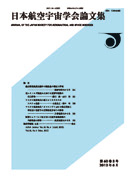All issues

Volume 34, Issue 393
Displaying 1-6 of 6 articles from this issue
- |<
- <
- 1
- >
- >|
-
Yukinori SATO1986 Volume 34 Issue 393 Pages 519-530
Published: October 05, 1986
Released on J-STAGE: May 25, 2009
JOURNAL FREE ACCESSDownload PDF (5723K) -
Manabu SANO, Yoshitada TAKAHATA1986 Volume 34 Issue 393 Pages 531-538
Published: October 05, 1986
Released on J-STAGE: May 25, 2009
JOURNAL FREE ACCESSIt becomes important in engineering to clear the flow field around finite multi-bodies placed vertically on a flat plate. In these cases, the flow field around them are different from that around a single body by fluid dynamic interaction. In this paper, aerodynamical forces on two finite rectangular prisms placed vertically on a flat plate are experimentally studied on a straight arrangement parallel to the approaching flow in the turbulent boundary layer. Surface static pressure are measured. Then pressure drag, falling moment and force-exerted points are calculated. Aerodynamical forces for various pitch (gaps of two bodies) are related with characteristic factors of the turbulent boundary layer. In addition, flow patterns around them are visualized by oil tracer method.View full abstractDownload PDF (960K) -
Comparison with the Same Bar Subjected to Central Compression Loads at EndsAihiko YOSHIZAWA, Masatsugu KURANISHI1986 Volume 34 Issue 393 Pages 539-544
Published: October 05, 1986
Released on J-STAGE: May 25, 2009
JOURNAL FREE ACCESSAn elastoplastic behavior of uniform bars with initial deflection under opposite tension loads at ends has been already reported in previous reports 1 and 2. The present paper treats the comparison of this case with the well known case where an initially deflected uniform bar is subjected to central compression loads at ends, pointing out differences between these two cases, as follows. In case of tension the bending moment first rises to a maximum value, afterward reduces gradually and then converges to an ultimate state where the bending moment is reduced to naught, while the axial force keeps its value. Contrary to this, in case of compression the buckling occures, the axial force reaches its maximum value and then the axial force gradually reduces up to an ultimate state where the balancing axial force becomes naught, while the bending moment takes its maximum value.View full abstractDownload PDF (336K) -
Masahiko MUROZONO, Seinosuke SUMI1986 Volume 34 Issue 393 Pages 545-553
Published: October 05, 1986
Released on J-STAGE: May 25, 2009
JOURNAL FREE ACCESSIn this paper we deal with an experimental verification of themally-induced torsional vibration of thin-walled boom with open circular cross section subjected to radiant heating. Tip mass is attached to one end of the boom made of beryllium copper. The boom is heated by the unidirectional radiation heating source. Responses of tip rotation angle and temperature obtained from the experiments conducted in a vacuum chamber are compared with the theoretical results which are based on one-degreeof-freedom analytical model. And it is verified that self-excited vibration can occur actually when the radiation input to boom is large. The critical point that divides the system into stability and instability is also confirmed experimentally and it agrees well with the theoretically predicted result.View full abstractDownload PDF (2405K) -
Junji HAYAKAWA, Masaki MAKIHARA, Masayuki NOGAMI, Thoru KOMIYAMA, Yosh ...1986 Volume 34 Issue 393 Pages 554-559
Published: October 05, 1986
Released on J-STAGE: May 25, 2009
JOURNAL FREE ACCESSGlass melting test in an accoustic levitation furnace has been carried out in the microgravity environment of 0.1-0.001G and lasted about 20sec. Composition of the glass was 65CaO·25Ga2O3·10GeO2 (in mol%). Sample was prepared so as to be convenient for observing a sequence of melting and glassifing behavior at high temperature in the microgravity. The heat source of the accoustic furnace was 1, 000W halogen lamp. The sample was confirmed to be a sphere owing to the surface tension at molten state and to levitation in the furnace by accoustic potential for the duration of microgravity.View full abstractDownload PDF (3013K) -
Tomoari NAGASHIMA, Takeichiryo HIROSE, Yoshiharu SUGIYAMA, Sadakane NI ...1986 Volume 34 Issue 393 Pages 560-570
Published: October 05, 1986
Released on J-STAGE: May 25, 2009
JOURNAL FREE ACCESSBased on the finite rotating beam element model with variable cross section, the vibration characteristics of a swept back rotor blade are analysed. To grasp the effects of tip geometries on its natural frequencies and mode shapes, vibration testings on the model blades with various plan forms are also conducted. The node lines of the rotating blades are measured remotely by utilizing the syncronized still video pictures on a CRT. The comparisons of numerical results with experimental ones show well coincidence and usefulness of the proposed method is ascertained.View full abstractDownload PDF (2706K)
- |<
- <
- 1
- >
- >|